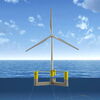Winds of change | An Eliot inventor uses simple physics to build a better turbine
 Photo/Jim Kozubek
Scott Moffat (left) and Ben Brickett of Blue Water Concepts say their prototype windmill is a more efficient way to harness wind power
Photo/Jim Kozubek
Scott Moffat (left) and Ben Brickett of Blue Water Concepts say their prototype windmill is a more efficient way to harness wind power
Benjamin Brickett lives on a restful farm along the limpid Piscataqua River estuary. But as an engineer and serial inventor, his is the homestead of a tinkerer.
On his kitchen table at his Eliot home is a device that enables the transfer of fluids and electricity in hostile ocean environments. Brickett holds six patents for inventions, such as a microchip-embedded fishing line and a tension line cutter that allows ensnared whales to escape. A former employee of the Michigan-based automotive safety company TRW Inc. and G&H Technologies Inc. in California, he honed his engineering skills working on deep-ocean and deep-space technologies.
Rarely, though, has he been this delighted to reveal a new invention. He walks to the side yard where a six-blade turbine that looks like an ultralight aircraft hums in the wind. “Something like this has never been built before,” Brickett says of his invention. “I have been working on turbines for 30 years and I know what works and what doesn’t.”
This wind turbine, or “variable force generator,” turns in winds as soft as 2 miles per hour or as fierce as 60 miles per hour, hence the “variable force.” But what makes it truly unique, says Brickett, is how it maximizes the force from its blades, converting it directly into AC electricity, bypassing the conventional gear box.
Brickett says the prototype model has one moving part — not much to wear out — and could be twice as energy efficient as existing windmills. The key to its efficiency lies in the multi-blade generator assembly. Each turbine has multiple, high-torque blades that are directly attached to a large magnetized rotor. As the wind blows and blade lift is established, the vectored drag force displaces the rotor, pushing it into an inductive coil chamber like the clutch on a transmission. The electrical power produced is directly proportional to the power of the wind at any time.
“I came up with the idea by accident,” Brickett says. “I had the axle loose on a turbine I was working on and it was pushing my hand back in the wind.”
The machines don’t stop turning, which means they rarely stall, or freeze up and continuously produce power even in light winds.
Brickett obtained $12,000 in seed money from the Maine Technology Institute and is now seeking venture capital and grants to manufacture the first round of 100 prototypes, which he intends to sell through his company, Blue Water Concepts, for $5,000 to $10,000. The prototype has already drawn interest from academia and some manufacturers, he says.
The windmills are designed to generate 2 to 5 kilowatts of electricity. Blue Water Concepts plans to offer a lifetime guarantee on the prototypes, allowing the company to track and improve the turbines based on customer feedback, says Brickett. He wants to manufacture the blades in Maine and as many of the other components as possible.
“The technology has got to stay here and put people to work,” says Brickett. “I’m very adamant about that. I don’t want this technology to go overseas and then be in the position of having to buy these turbines back at ridiculous prices.”
Brickett and his business partner, Scott Moffat, want to follow the prototype with a 10- to 50-kilowatt turbine, and then investigate an industrial grade turbine.
“Have we run this turbine for years? No,” says Moffat. “But we made a prototype that is robust, and we’ve been told it’s disruptive technology, like what the jet did to piston-powered airplanes.”










Comments